|
Nancy Brashear and Carolyn Angus In 2020, we welcomed the release of new editions of some old favorites. Join us in celebrating the anniversaries of these picture books and novels that were loved by readers when they were first published and will make meaningful and exciting reading for those discovering them for the first time. 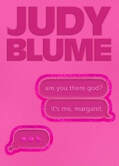 Are You There God? It’s Me, Margaret (50th Anniversary Edition). Judy Blume. (2020). Richard Jackson/Atheneum. Almost twelve-year-old Margaret’s life changes when her family moves from New York City to Farbrook, New Jersey. The new girl in class, she becomes a member of a secret club, the Four PTS’s (Pre-Teen Sensations) and tries to fit in despite their cliquish ways and preoccupation with personal bodily changes and boys. She’s also the only girl whose family doesn’t belong to a synagogue or church. Since her parents have told her she can choose a religion for herself when she’s grown up, this becomes an important part of her regular private conversations with God about intimate aspects of her life. For her year-long school project, Margaret conducts an experiment in religion. She reads books on Judaism and Christianity and visits Temple Israel and various Protestant and Catholic churches. Her conclusion: Twelve is very late to learn about religion. The 50th anniversary edition of this middle-grade novel in which Judy Blume deals with the important certainties and uncertainties of adolescence with understanding and wit features a rose-colored faux leather embossed cover. (Gr 6-8) 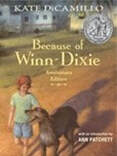 Because of Winn-Dixie (20th Anniversary Edition). Kate DiCamillo. (2020). Candlewick. India Opal Buloni lives in Naomi, Florida, where her father is the new preacher at the Open Arms Baptist Church. Opal is preoccupied with wanting to understand why her mother left when she was an infant and why her father never wants to talk about her. Opal convinces her father to let her keep the unkempt, stray dog she names Winn-Dixie (named after the grocery store where she found him). Winn-Dixie becomes Opal’s entry into interconnected friendships with elderly Gloria Dump at the “haunted house,” Miss Franny at the library, Otis at the pet store, and others in the neighborhood. Opal learns that most people have suffered loss and that “you can only love what you got while you got it.” This anniversary edition of Kate DiCamillo’s 2001 Newbery Honor book features an introduction by author Ann Patchett and an afterword by DiCamillo. (Gr 3-5) 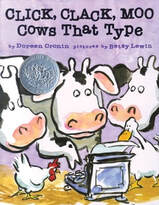 Click, Clack, Moo: Cows That Type (20th Anniversary Edition). Doreen Cronin. Illus. by Betsy Lewin. (2020). Caitlyn Dlouhy/Atheneum. “Click, clack, moo. Click, clack, moo. Clickety, clack, moo.” The cows use the old typewriter they find to write a note to Farmer Brown requesting electric blankets because it’s cold in the barn. When no blankets appear, they post another note on the barn door. “Sorry. We’re closed. No milk today.” After the hens join the strike, Farmer Brown sends Duck, a “neutral party,” with his demand for milk and eggs. The cows respond with a compromise that the farmer accepts: an exchange of the typewriter for blankets. Betsy Lewin’s humorous 2001 Caldecott Honor-winning illustrations show the cows and hens sleeping contently under their electric blankets, but instead of the typewriter, Farmer Brown gets a message from the ducks. “Click, clack, quack. Click, clack, quack. Clickety, clack, quack.” The promise of more trouble and fun in the barnyard suggested by this ending has been fulfilled in Cronin and Lewin’s numerous additions to the Click, Clack, Moo series. (PreK-Gr2) 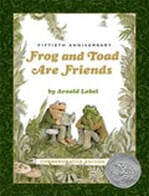 Frog and Toad Are Friends (50th Anniversary Commemorative Edition). Arnold Lobel. (2020). Harper/HarperCollins. To celebrate the 50th anniversary of Arnold Lobel’s 1971 Caldecott-Honor-winning Frog and Toad Are Friends, HarperCollins reissued this first Frog and Toad book (originally published in the I Can Read series) in a larger picture book format. Five short stories—“Spring,” “The Story,” “A Lost Button,” “A Swim,” and “The Letter”—tell about the small dilemmas of two best friends who always seem to enjoy themselves as they help each other out. Bonus material in this commemorative edition includes archival photographs, a biography of Arnold Lobel (1933-1987), notes and sketches on the origin of Frog and Toad, information on Lobel’s process of writing and creating the artwork for the book, and quotes. Plan on continuing the joy of reading this beloved classic by sharing Frog and Toad Together (1972), Frog and Toad All Year (1976), and Days with Frog and Toad (1979). (PreK-Gr2) 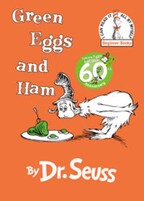 Green Eggs and Ham. Dr. Seuss. (1960). Beginner Books/Random House. “Do you like / green eggs and ham?” // “I do not like them, / Sam-I-am. / I do not like / green eggs and ham.” Dr. Seuss is at his best in the use of rhyme and repetition as Sam-I-am offers up green eggs and ham in different nonsensical ways in various locations and with three animals (mouse, fox, and goat) in an effort to entice a decidedly contrary older Seussian character to just try them. Finally, agreeing to do so if Sam-I-am will stop pestering him, he licks the platter clean. “I do like / green eggs and ham! / Thank you! Thank you, / Sam-I-am!” This fun to read I Can Read It All by Myself Beginner Book, created by Theodor Geisel (1904-1991) using only fifty words, celebrated its 60th anniversary in 2020. (PreK-Gr2) 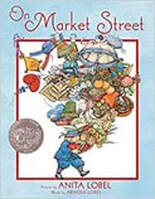 On Market Street. Arnold Lobel. Illus. by Anita Lobel. (2020). Paula Wiseman/Simon & Schuster. On a stroll along Market Street, a young boy buys twenty-six presents for a friend from merchants exquisitely dressed in items for sale in their shops. At the end of the day, having spent all his coins on Market Street, the boy returns home with an alphabet of gifts—apples, books, clocks, doughnuts, . . . yarn, zippers—to present to his cat before he and the cat nestle in bed for the night. As Anita Lobel explains in an illustrator’s note, Arnold Lobel wrote the “bookend” verses that frame her alphabet of imaginatively dressed shopkeepers inspired by a display of seventeenth-century posters of figures constructed of objects of trades she saw in Paris. This 1982 Caldecott Honor book, originally published by Greenwillow Books, is celebrating its 40th anniversary in 2021. (PreK-Gr 2) 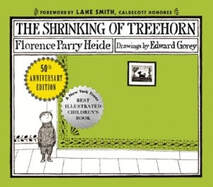 The Shrinking of Treehorn (50th Anniversary Edition). Florence Parry Heide. Illus. by Edward Gorey. (2020). Holiday House. Treehorn is shrinking, day by day, and his parents don’t seem to be concerned. At breakfast, he sits on a pile of cushions so he can finish off his cereal and send away for the game advertised on the back of the box. He needs help getting his piggy bank down from the counter to pay for the game and can’t reach the mailbox without help. Even Treehorn’s teacher and principal don’t pay attention to what’s happening to him. One morning, smaller than ever, Treehorn spies his unfinished cereal box game, The Big Game for Kids to Grow On, under his bed and ingeniously takes control of the situation himself. That is, until later, when he notices he’s green all over and sighs, “If I don’t say anything, they won’t notice.” Edward Gorey’s distinctive pen-and-ink drawings perfectly match Florence Parry Heide’s quirky, melancholic story of how it feels to be ignored. New features include a foreword by author Lane Smith, a February 2010 interview with the author from curiouspages.blospot.com, and an article by her son published in the Kenosha News in 2009. (PreK-Gr 2) 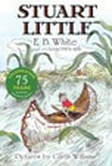 Stuart Little (75th Anniversary Edition). E. B. White. Illus. by Garth Williams. (2020). Harper/HarperCollins. Stuart Little, a mouse born to a human family, sets out on the biggest adventure of his life when he runs away from home to look for his best friend Margalo, a little bird who has mysteriously disappeared. Stuart, who has outwitted the Little’s cat, navigated the streets of New York City, and steered a toy schooner on a perilous course to win a sailboat race in Central Park, confidently heads north, knowing the way will be long. “But the sky was bright, and he somehow felt he was headed in the right direction.” White’s final sentence leaves the reader not knowing whether Stuart and Margalo are reunited but feeling that, for adventure-loving Stuart, the search was the important thing. This special edition includes a foreword by author Sara Pennypacker and two bonus items from HarperCollin’s archives: the cover letter White sent to his editor along with an unfinished manuscript for Stuart Little and a 1945 catalog advertisement for the book. (Gr 3-5) 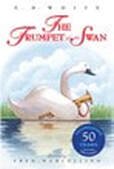 The Trumpet of the Swan (50th Anniversary Edition). E. B. White. Illus. by Fred Marcello. (2200. Harper/HarperCollins. Louis is a trumpeter swan who was born voiceless. Although he has learned to read and write by going to school with Sam Beaver, a boy he first met in the wilderness of western Canada, and can communicate with humans by writing on a slate, Louis is still unable to connect orally with other swans. His father’s stealing of a brass trumpet from a music store so that Louis can honk “Ko-hoh, ko-hoh!” leads to much more than just the ability to woo Serena, the swan he loves. This special edition includes a foreword by John Lithgow and bonus material: a 1970 advertisement for the book in the New York Times; a letter from E. B. White to his editor, Ursula Nordstrom; a letter White sent to readers; and excerpts from Charlotte’s Web and Stuart Little. For a special treat, enjoy the Listening Library (2006) audio production of The Trumpet of the Swan read by E. B. White, which includes trumpet playing that brings Louis’ music to life. (Gr 3-5)  The Watson Go to Birmingham—1963 (25th Anniversary Edition). Christopher Paul Curtis. (2020). Yearling/Random House. Ten-year-old African American Kenny Watson and the other “Weird Watsons.” (Momma, Dad, younger sister Joetta, and thirteen-year-old Byron) live in Flint, Michigan. After Byron, an “official juvenile delinquent,” continues to get into trouble, Momma decides it’s time for Grandma Sands to straighten him out during the summer, so the Watsons pile into the Brown Bomber, the family car, and head to Birmingham, Alabama. Kenny is shocked by segregation in the South and the blatant and dangerous attitudes of some whites toward blacks. On a Sunday, when Joetta is in Sunday School, the church is bombed. Kenny witnesses the aftermath and believes his sister has been killed. Although it turns out Joetta is safe, four young girls died that day. The Watson family returns to Flint with Kenny forever changed by his personal introduction to the tragedies of racial injustice. This paperback edition of Christopher Paul Curtis’ Newbery Honor-winning book includes a new foreword and afterword by the author; tributes by Jacqueline Woodson, Kate DiCamillo, and Varian Johnson; original manuscript pages; a letter from the 1996 Newbery committee; and a map of the Watson’s journey. (Gr 3 Up) Nancy Brashear is Professor Emeritus of English from Azusa Pacific University, in Azusa California. Carolyn Angus is former Director of the George G. Stone Center for Children’s Books, Claremont Graduate University, in Claremont, California.
1 Comment
|
AuthorsThese reviews are submitted by members of the International Literacy Association's Children's Literature and Reading Special Interest Group (CL/R SIG). Archives
May 2024
Categories
|

 RSS Feed
RSS Feed